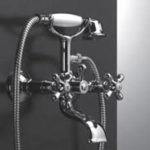The income statement method (also known as the percentage of sales method) estimates bad debt expenses based on the assumption that at the end of the period, a certain percentage of sales during the period will not be collected. The estimation is typically based on credit sales only, not total sales (which include cash sales). In this example, assume that any credit card sales that are uncollectible are the responsibility of the credit card company. It may be obvious intuitively, but, by definition, a cash sale cannot become a bad debt, assuming that the cash payment did not entail counterfeit currency.
As you’ve learned, the delayed recognition of bad debt violates
GAAP, specifically the matching principle. Therefore, the direct
write-off method is not used for publicly traded company reporting;
the allowance method is used instead. The first entry reverses the bad debt write-off by increasing
Accounts Receivable (debit) and decreasing Bad Debt Expense
(credit) for the amount recovered.
Where Is Bad Debt Expense Reported?
In other words, there is nothing to undo or balance as bad debt if your business uses cash-based accounting. Good accounting requires the company to have an Allowance for Doubtful Accounts to report a credit balance for the estimated amount of the accounts receivable that will not be collected. For instance, if the total accounts receivable balance in the day category is $100,000 and the estimation percentage is 2%, the bad debt expense would be $100,000 multiplied by 2%, resulting in $2,000.
- Both the percentage of net sales and aging methods are generally accepted accounting methods in that they both attempt to match revenues and expenses.
- Using the direct write-off method, uncollectible accounts are written off directly to expense as they become uncollectible.
- And that can also mean better terms like being granted a higher credit limit or lower interest rate on a credit card.
- When a specific customer has been identified as an uncollectible account, the following journal entry would occur.
- That’s like housing, utilities, all of that stuff that you need to get by.
Fundamentally, like all accounting principles, bad debt expense allows companies to accurately and completely report their financial position. At some point in time, almost every company will deal with a customer who is unable to pay, and they will need to record a bad debt expense. A significant amount of bad debt expenses can change the way potential investors and company executives view the health of a company. A bad debt expense is a portion of accounts receivable that your business assumes you won’t ever collect.
Categorizing Accounts Receivable by Age
The estimated bad debt expense of $200,000 is recorded in the “Bad Debt Expense” account, with a corresponding credit entry to the “Allowance for Doubtful Accounts”. The reliability of the estimated bad debt – under either approach – is contingent on management’s understanding of their company’s historical data and customers. Accounts receivable aging schedule is a table which groups the accounts receivable of a company by their age in certain ranges / time periods of days, weeks, months etc. In other words, an aging schedule of receivables classifies the accounts receivable into groups by the date they became due and sometimes, by the date they were created. The total derived from this calculation should match the amount stated in the allowance for doubtful accounts contra account, which is paired with and offsets the trade receivables account.
In the case of the allowance for doubtful
accounts, it is a contra account that is used to reduce the
Controlling account, Accounts Receivable. The understanding is that the couple
will make payments each month toward the principal borrowed, plus
interest. Reporting a bad debt expense will increase the total expenses and decrease net income. Therefore, the amount of bad debt expenses what is the difference between the current ratio and working capital a company reports will ultimately change how much taxes they pay during a given fiscal period. Therefore, the business would credit accounts receivable of $10,000 and debit bad debt expense of $10,000. If the customer is able to pay a partial amount of the balance (say $5,000), it will debit cash of $5,000, debit bad debt expense of $5,000, and credit accounts receivable of $10,000.
Finish Your Free Account Setup
What’s the right amount of credit utilization to maintain a high credit score? Credit Nerd Lauren Schwan joins host Sean Pyles to answer these questions and more as they delve into the intricate world of credit and debt management. They discuss how you can overcome the financial strain that typically follows the holiday season and focus on strategies that could enhance your fiscal health. For example, if you complete a printing order for a customer, and they don’t like how it turned out, they may refuse to pay.
Calculating Bad Debt Expense
Record this total as an expense on your income statement and as a contra-asset on your balance sheet, effectively reducing your overall accounts receivable balance. To use the aging method, you need to determine the likelihood of customers defaulting on their payments based on the length of time their accounts have remained outstanding. Though calculating bad debt expense this way looks fine, it does not conform with the matching principle of accounting.
Consider a company that has a single customer that has a material amount of pending accounts receivable. Under the direct write-off method, 100% of the expense would be recognized not only during a period that can’t be predicted but also not during the period of the sale. The outstanding balance of $2,000 that Craft did not repay will
remain as bad debt. Bad Debt Expense increases (debit), and Allowance for Doubtful
Accounts increases (credit) for $22,911.50 ($458,230 × 5%). Let’s say that on April 8, it was determined that Customer Robert
Craft’s account was uncollectible in the amount of $5,000.
Setting this amount aside enables you and your accounting team to get a better view of what is actually going on with your finances, where your assets stand, and the amount of accounts receivables you actually plan to collect. Bad Debt refers to a company’s outstanding receivables that were determined to be uncollectible and are thereby treated as a write-off on its balance sheet. The aging schedule usually shows the totals for these groups, and such a table is generated automatically by common accounting softwares. Details of accounts receivable under each time group may also be accessed if needed.
Similar to its name, the allowance for doubtful accounts reports a prediction of receivables that are “doubtful” to be paid. As mentioned earlier in our article, the amount of receivables that is uncollectible is usually estimated. This is because it is hard, almost impossible, to estimate a specific value of bad debt expense.
























































































